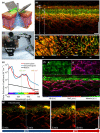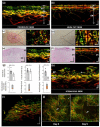Non-invasive imaging in dermatology and the unique potential of raster-scan optoacoustic mesoscopy
- PMID: 30422337
- PMCID: PMC6563473
- DOI: 10.1111/jdv.15342
Non-invasive imaging in dermatology and the unique potential of raster-scan optoacoustic mesoscopy
Abstract
In recent years, several non-invasive imaging methods have been introduced to facilitate diagnostics and therapy monitoring in dermatology. The microscopic imaging methods are restricted in their penetration depth, while the mesoscopic methods probe deeper but provide only morphological, not functional, information. 'Raster-scan optoacoustic mesoscopy' (RSOM), an emerging new imaging technique, combines deep penetration with contrast based on light absorption, which provides morphological, molecular and functional information. Here, we compare the capabilities and limitations of currently available dermatological imaging methods and highlight the principles and unique abilities of RSOM. We illustrate the clinical potential of RSOM, in particular for non-invasive diagnosis and monitoring of inflammatory and oncological skin diseases.
© 2018 The Authors. Journal of the European Academy of Dermatology and Venereology published by John Wiley & Sons Ltd on behalf of European Academy of Dermatology and Venereology.
Figures


Similar articles
-
Optoacoustic imaging and potential applications of raster-scan optoacoustic mesoscopy in dermatology.Clin Dermatol. 2022 Jan-Feb;40(1):85-92. doi: 10.1016/j.clindermatol.2021.12.001. Epub 2021 Dec 17. Clin Dermatol. 2022. PMID: 34923064 Review.
-
Implications of ultrasound frequency in optoacoustic mesoscopy of the skin.IEEE Trans Med Imaging. 2015 Feb;34(2):672-7. doi: 10.1109/TMI.2014.2365239. Epub 2014 Oct 28. IEEE Trans Med Imaging. 2015. PMID: 25361501
-
Skin Surface Detection in 3D Optoacoustic Mesoscopy Based on Dynamic Programming.IEEE Trans Med Imaging. 2020 Feb;39(2):458-467. doi: 10.1109/TMI.2019.2928393. Epub 2019 Jul 12. IEEE Trans Med Imaging. 2020. PMID: 31329549
-
Motion correction in optoacoustic mesoscopy.Sci Rep. 2017 Sep 4;7(1):10386. doi: 10.1038/s41598-017-11277-y. Sci Rep. 2017. PMID: 28871184 Free PMC article.
-
Raster Scan Optoacoustic Mesoscopy for detecting microvascular complications in diabetes mellitus: A narrative brief review.Diabetes Res Clin Pract. 2025 Apr;222:112095. doi: 10.1016/j.diabres.2025.112095. Epub 2025 Mar 10. Diabetes Res Clin Pract. 2025. PMID: 40073947 Review.
Cited by
-
Photoacoustic Imaging of Tattoo Inks: Phantom and Clinical Evaluation.Appl Sci (Basel). 2020 Feb;10(3):1024. doi: 10.3390/app10031024. Epub 2020 Feb 4. Appl Sci (Basel). 2020. PMID: 33604062 Free PMC article.
-
Quality control in clinical raster-scan optoacoustic mesoscopy.Photoacoustics. 2023 Dec 22;35:100582. doi: 10.1016/j.pacs.2023.100582. eCollection 2024 Feb. Photoacoustics. 2023. PMID: 38312808 Free PMC article.
-
Non-invasive Approaches for the Diagnosis of Autoimmune/Autoinflammatory Skin Diseases-A Focus on Psoriasis and Lupus erythematosus.Front Immunol. 2019 Aug 21;10:1931. doi: 10.3389/fimmu.2019.01931. eCollection 2019. Front Immunol. 2019. PMID: 31497014 Free PMC article. Review.
-
[Molecular diagnostics of hand eczema].Hautarzt. 2019 Oct;70(10):760-765. doi: 10.1007/s00105-019-4466-9. Hautarzt. 2019. PMID: 31468073 Review. German.
-
Fibrotic Disease: from Signaling Pathways and Biomarkers to Molecular Imaging.Mol Imaging Biol. 2025 Aug 11. doi: 10.1007/s11307-025-02038-9. Online ahead of print. Mol Imaging Biol. 2025. PMID: 40790290 Review.
References
-
- Koehler MJ, Speicher M, Lange‐Asschenfeldt S et al Clinical application of multiphoton tomography in combination with confocal laser scanning microscopy for in vivo evaluation of skin diseases. Exp Dermatol 2011; 20: 589–594. - PubMed
-
- Ulrich M. Konfokale laserscanmikroskopie. Der Hautarzt 2015; 66: 504–510. - PubMed
-
- Themstrup L, de Carvalho N, Nielsen SM et al In vivo differentiation of common basal cell carcinoma subtypes by microvascular and structural imaging using dynamic optical coherence tomography. Exp Dermatol 2018; 27: 156–165. - PubMed
-
- Ntziachristos V. Going deeper than microscopy: the optical imaging frontier in biology. Nat Methods 2010; 7: 603–614. - PubMed
Publication types
MeSH terms
Grants and funding
LinkOut - more resources
Full Text Sources
Medical

